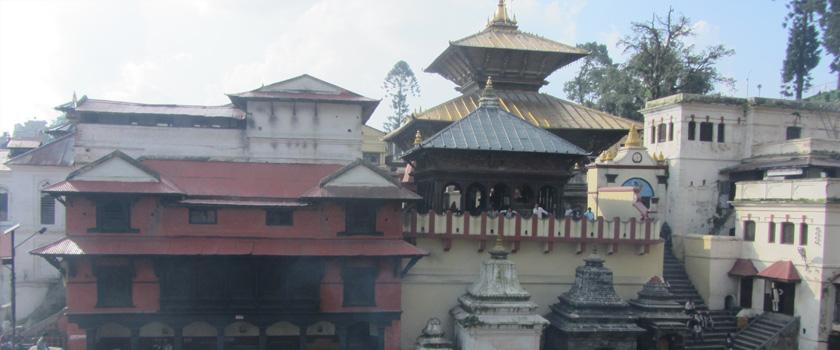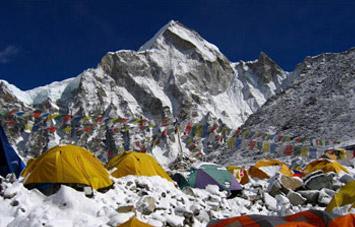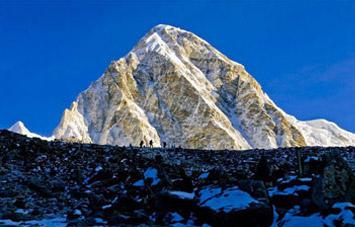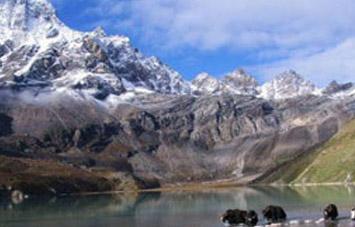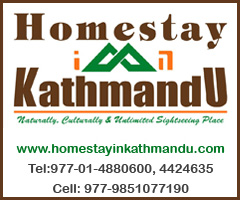Kathmandu Valley Tour
Overview
Trip Information
Kathmandu Valley is the capital and largest urban agglomerate of Nepal. Here you will visit the temple of the Living Goddess who acknowledges the greetings of the devotees from the balcony of her temple residence. Kashtamandap temple - the source of the name Kathmandu and is supposed to be made from the timber of a single tree.It is also known as The city of temples.
1.Pashupatinath Temple
Situated 5 kilometers east of Kathmandu City, Pashupatinath temple is one of the holiest temples dedicated to Lord Shiva. Situated amidst a lush green natural setting on the bank of the sacred Bagmati river, the temple built in pagoda style has a jilted roof and richly carved silver doors. Visitors are permitted to view the temple from the east bank of the Bagmati River, as entrance to the temple is strictly forbidden to all non Hindus. Pashupatinath is the center of the annual pilgrimage on the day of Shivaratri which falls in the month of February or March. Behind the temple are the cremation grounds.
Every year this temple attracts hundreds of elderly followers of Hinduism.They arrive here to find shelter for the last several weeks of their lives, to meet death, be cremated on the banks of the river and travel their last journey with the waters of the sacred river Bagmati, which later meets the holy river Ganges.It is believed that those who die in Pashupatinath Temple are reborn as a human, regardless of any misconduct that could worsen their karma. The exact day of their death is predicted by astrologers of the temple. If you are attracted to the places where the spirit of death can be felt, then consider Pashupatinath as your first destination. It is a temple with special atmosphere of death; death is present in almost every ritual and every corner of it.
2.Boudhanath Stupa
This Stupa, 8 kilometers east of Kathmandu City, is one of the biggest in the world of its kind. It stands with four pairs of eyes in the four cardinal directions keeping watch for righteous behavior and human prosperity. This Buddhist Stupa was built by King Man Deva at the advice of the Goddess Mani Jogini. It is built on an octagonal base inset with prayer wheels. The shrine is ringed by houses of Lamas or Buddhist priests.
Built some time around the 14th century, the huge meditative monument is said to have been created just after the passing of the Buddha. The huge offering site quickly become an focal point of worship and offering in the area. The structure of the building consists of a giant dome, on the top which sits a Buddhist pyramid tower. All of this sits on top of huge steps shaped like mandalas themselves. Originally the stupa’s spot was on an important trade route which allowed for a steady stream of possible converts. Among the Nepalese in Kathmandu, the stupa is simply referred to as “Chorten Chenpo” which translates to “Great Tower” or just “Great Stupa.” No matter what pilgrims called it, they flocked to the monument in droves.
Despite having existed for years, the site did not truly become the center of Tibetan Buddhism until the 1950s as refugees from China immigrated over to Kathmandu. Temples and devotional sites began to spring up throughout the surrounding city and further far afield, strengthening the power and importance of the site immeasurably.
While it is hard to determine their specific age, the base of the stupa tower is decorated with pairs of eyes on each of the cardinal directions representing the all-knowing nature of the Buddha. However, for those not fully indoctrinated into Buddhist belief, the building (while quite peaceful and beautiful) does seem to be peering down on visitors as they come to make offerings or just to see one of the more spectacular Buddhist sites in the world.
3.Swayambhunath Stupa
Located approximately 4 kilometers west of Thamel, this Buddhist Stupa is said to be 2000 years old. The Stupa which forms the main structure is composed of a solid hemisphere of brick and earth supporting a lofty conical spire capped by a pinnacle of copper gilt. Painted on the four sided base of the spire are the all seeing eyes of Lord Buddha. This hill is a mosaic of small Chaityas and Pagoda temples.
Swayambhu Nath Stupa is popular temple in Kathmandu valley for both religious people of Buddhist and Hindus, lies 3km west . It is located 77m above the sea level of the Kathmandu valley.Swayambhunath Temple also called the `Monkey Temple' because of the many hundreds of monkeys who scamper around the temple. Swayambhunath's worshippers include Hindus, Vajrayana Buddhists of northern Nepal and Tibet, and the Newari Buddhists of central and southern Nepal. Each morning before dawn, hundreds of pilgrims will ascend the 365 steps that lead up the hill.
It was listed in the UNESCO World Heritage Monument List in 1979.The history of the Valley, according to the legends, the lotus mysteriously radiated a brilliant light, and the name of the place came to be Swayambhu, meaning 'Self-Created or Self-Existent'. Bodhisattva Manjusri came across a beautiful lake during his travel. He saw a lotus that emitted brilliant light at the lake's center, so he cut a gorge in a southern hill and drained the waters to worship the lotus. The lotus was then transformed into a hill and the light became the Swayabhunath Stupa. Men settled on the bed of the lake and called it the Kathmandu Valley. From then on, the hilltop of the Self-existent Lord has been a holy place.
4.Hanumandhoka Durbar Square(The Palace of the living Goddess-Kumari)
Hanuman Dhoka square ( "UNESCO World Heritage Site") also known as Kathmandu Durbar Square is one of the major attractions in Kathmandu Valley. Most of the cultural centers of Nepal are concentrated around the Kathmandu valley; among those cultural sites, the important one is the Hanuman-dhoka Durbar Square. The name Hanumandhoka Durbar came from the statue of Hanuman established by the King Pratap Malla at the entrance of the royal palace in 1672 A.D. storeyed residence built by King Prithvi Narayan shah in 1770,is called Basantapur Durbar(palace). The whole complex is also known as Kathmandu Durbar Square. Located at the heart of ancient city in Kathmandu it is srounding both Hindu and Buddhist temple. Most of them are built in the pagoda style embellished with intricately carved exteriors as well as Most of the buildings we see here date from 15th to 18th century . The Durbar Square, with its old temples, palaces, epitomizes the religious and cultural life of the people. The major Interesting things to see here are "Kumari (The Living Goddess) Ghar" ,Kastha Mandap,Maru Ganesh, Mahadev Temple, Shiva Parvati Temple, Bhagwati Temple, Old palace, Saraswoti temple, Krishna Octangular Temple, Big drums, Kal Bhairav, Jagannath Temple, and Taleju Temple etc.
The Durbar Square are is actually made up of two sub-areas. The outer complex is renowned for numerous interesting temples as Kumari Ghar , Kasthamandap , Shiv-Parbati Temple, Jagannath Temple, Big Bell etc ,while the inner complex comprises the old palace area ,Hanuman-dhoka and its courtyards as Nasal Choke ,Mul Choke ,Sundari Choke, Basantapur Durbar and other. Besides the magnificent temples and shrines, it has other interesting aspects are various festivals , cultural activities and traditions people are following from centuries, which are presented in the Durbar Square. The major festivals include Indrajatra, Dashain, Gaaijatra, Machchhindra-nath jatra etc. These are the occasion when the people from all over the city gather here to mark their centuries old traditions. All the carving and architecture in this area are exceptionally fine which make the architecture in this Hanuman-dhoka Durbar square among the most important sights for travelers to see.
5.Patan Durbar Square
5 kilometers away from Kathmandu city is Patan, also known as Lalitpur, and is the city of fine arts. Enclosed within the city are 4 Stupa which are said to have been built in the 3rd century AD by Emperor Ashoka. It is listed in the UNESCO World Heritage site.
Patan, the oldest of all the three cities of Kathmandu valley. It is the best known for its artistic heritage. It is one of the oldest Buddhist City in the world. The city is situated on a plateau across Bagmati River. Another name of Patan, is Lalitpur. The city is surrounded by 4 Stupas as 4 corners of Patan, one at each corner of its cardinal points. This is one of the most elegant architectural treasures of which Patan is very proud. Really it is full of Hindu temples and Buddhist monuments with bronze gateways, guardian deities and wonderful carvings and many visitors come here to see the these monuments. Patan Durbar square is the famous visiting place. The square is full of ancient places, temples, and shrines noted for their exquisite carvings.
The former royal palace complex is the center of Patan's religious and social life and houses a museum containing an array of bronze statues and religious objects. There are three main courtyards or chowks, so named central Mul Chowk, Sundari Chowk and Keshav Narayan Chowk in the square. The Sundari Chowk holds in its center a masterpiece of stone architecture, the Royal bath called Tushahity.
The Major attraction of Patan Darbar Square
Patan Museum
This museum inside the durbar square specializes in bronze statues and religious objects. It is considered as one of the best museums in Asia.
Hiranya Varna Mahavihar
Located inside kwabadehul, this three- story golden pagoda of Lokeshwar (lord Buddha) was built in the twelfth century by king Bhaskar Verma. It is famous as the golden temple. Inside the upper story of the pagoda, are the golden images of lord Buddha and a large prayer wheel.
Golden Window
This was specially built for King Siddhi Narasingha malla. His devotion to Lord Krishna as well as the Buddhist God of compassion Karunamaya Lokeshwar is a famous episode in Nepalese history of religion.
Mahabouddha Temple
This temple of Buddha built interestingly in the Hindu Shikara style- has five golden pinnacles. They are all in a stupa shape very symbolic of five basic elements.
Golden Temple
This golden temple of Buddha in Patan is the oldest richest and most famous monument indeed. It was built 12th century is known for its beautiful gold works shining very graciously.
Krishna Temple
The Famous Temple Which was built in the 17th century, the temple of Lord Krishna holds a commanding position in the palace complex of Patan. It is the only temple in Nepal to have 21 shrines and is completely made of stone. Most of the important scenes from the ancient Hindu epics the Ramayana and the Mahabharata, have been engraved on its friezes.
6.Bhaktapur Durbar Square
Bhaktapur Durbar Square the city is also known, is a museum of medieval art and architecture with many examples of sculpture, woodcarving and colossal pagoda temples consecrated to different gods and goddesses which is 15 km far from Kathmandu. It is a conglomeration of pagoda and shikhara-style temples grouped around a fifty-five window palace of brick and wood. The square is one of the most charming architectural showpieces of the Valley as it highlights the ancient arts of Nepal. The golden effigies of kings perched on the top of stone monoliths, the guardian deities looking out from their sanctuaries, the wood carvings in every place-struts, lintels, uprights, tympanums, gateways and windows-all seem to form a well-orchestrated symphony. Pottery and weaving are its major traditional industries.It was listed in the UNESCO world Heritage Monument List in 1979.
The Major attraction of Bhaktapur Darbar Square are
55 Window Palace
This is the main architectural structure dominating the entire Durbar Square. This magnificent monument was built in 15th century AD. Seated on a huge column top in a position of prayer to God is King Bhupatindra Malla.
Golden Gate
This is the main entrance to the palace. The craftsman who worked on this wonderful gate must be from Heaven. It is an eternal beauty in itself.
Lion's Gate
This gate has two beautiful stone statues of Hindu deities installed on its either side. It is said that the hands of the artisans who made this were cut off immediately after he gave a finishing touch to them. A jealous Bhadgaon King did this so that the artisan could not produce any more of such arts.
Mini Pashupati Temple
Some people call it a royal dream temple. Folklore says - once a Bhadgaon King who was a great devotee to Lord Pashupati had a dream in which Lord told the king to build a temple for Pashupati right in front of this palace.
Vatsala Temple
This temple dedicated to a mother goddess is full of intricate works on stone. This temple is known for its dog-barking bell. This bell is believed to produce a death knell when it is rung up.
Nyatapola Temple
This is the most famous pagoda of Nepal. Nyatapola in Newari language means fie tires - the symbolic of five basic elements. This is the highest pagoda of Nepal ever built with such architectural perfection and artistic beauty. This temple is dedicated to Sidhilaxmi, the tantric goddess of supreme power and success.
Bhairava Nath Temple
This temple is dedicated to Bhairava the God of terror and death,
Detail Itinerary
Day 1 : Arrival at Tribhuwan International Airport and transfer to hotel. Stay overnight at hotel in Kathmandu.
Day 2 : Sightseeing tour of Pashupatinath, Boudhanath ,Swayambhunath and Kathmandu Durbar Square. Stay overnight at hotel in Kathmandu.
Day 3 : Sightseeing tour of Patan Durbar Square and Bhaktapur Durbar Square and drive back to Kathmandu. Stay overnight at hotel in Kathmandu.
Day 4 : Fly out from Kathmandu.
NOTE: You can also add Mountain Flights and Helicopter Tours to your itinerary.
What's Included
Included in the Cost
- Airport pick-up and drop
- Hotel in Kathmandu
- City tours with transport and tour guide
- Entrance Fee
Not Included in the Cost
- Travel Insurance
- Tips, Bar bills
- Personal Expense
Trip Fact
- Duration: 4 Day(s)
- Activities: Nepal Tour
- Group size: Min 1
SIMILAR TRIPS
People who viewed this tour also like...




